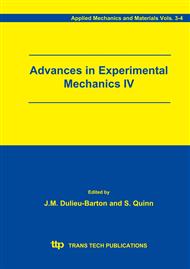p.79
p.85
p.91
p.99
p.105
p.111
p.117
p.125
p.131
The Application of Fine Increment Hole Drilling for Measuring Machining-Induced Residual Stresses
Abstract:
Hole drilling is one of the most widely used techniques for measuring residual stress, but the conventional approach is limited in the near surface detail that can be resolved. Because of concerns about the levels of induced residual stress that might develop during machining and surface treatment processes, there is significant interest in developing a technique that can obtain near-surface residual stress information by the application of fine-increment hole drilling. Critical information can be lost if conventional, large depth increments are used and the fine incremental hole drilling approach, using depth increments as small as 20µm, offers a cost effective and rapid solution, with the possibility of measuring near surface stresses. Results focus on three different machining studies and a shot peened specimen, all cases where the stress field changes rapidly through the depth, particularly close to the surface. A systematic assessment of machining parameters is not within the scope of this paper and is not presented, but work has focused on highlighting the application and potential of the fine increment hole drilling approach.
Info:
Periodical:
Pages:
105-110
Citation:
Online since:
August 2006
Authors:
Keywords:
Price:
Сopyright:
© 2005 Trans Tech Publications Ltd. All Rights Reserved
Share:
Citation:


